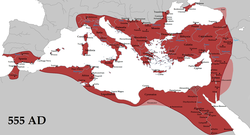ចក្រភពប៊ីហ្សីនទីន
ចក្រភពប៊ីហ្សីនទីន [note ១] ត្រូវបានគេសំដៅផងដែរថាជា ចក្រភពរ៉ូម៉ាំងខាងកើត ឬ ប៊ីហ្សានទីម គឺជាការបន្តនៃចក្រភពរ៉ូម នៅក្នុងខេត្តភាគខាងកើតរបស់ខ្លួនក្នុងកំឡុង សម័យបុរាណចុង និង យុគសម័យកណ្តាល នៅពេលដែលរដ្ឋធានីរបស់វាគឺខនស្ទែនទីណូបែល ។ វាបានរស់រានមានជីវិតពីការបែកបាក់ និង ការដួលរលំនៃចក្រភពរ៉ូមខាងលិច នៅសតវត្សទី ៥ នៃគ.ស ហើយបន្តមានរាប់ពាន់ឆ្នាំបន្ថែមទៀតរហូតដល់ការដួលរលំនៃខនស្ទែនទីណូបែល ទៅចក្រភពអូតូម៉ង់ ក្នុងឆ្នាំ១៤៥៣ ។ ក្នុងអំឡុងពេលភាគច្រើននៃអត្ថិភាពរបស់វា ចក្រភពនៅតែជាកម្លាំងសេដ្ឋកិច្ច វប្បធម៌ និងយោធាដ៏មានឥទ្ធិពលបំផុតនៅទ្វីបអឺរ៉ុប ។ ពាក្យ "ចក្រភពប៊ីហ្សីនទីន" និង "ចក្រភពរ៉ូមខាងកើត" ត្រូវបានបង្កើតឡើងបន្ទាប់ពីការបញ្ចប់នៃអាណាចក្រ។ ប្រជាជនរបស់ខ្លួនបានបន្តសំដៅទៅលើចក្រភពរបស់ពួកគេថាជា ចក្រភពរ៉ូម ហើយចំពោះខ្លួនពួកគេថាជាជនជាតិរ៉ូម [note ២] ដែលជាពាក្យដែលក្រិកបានបន្តប្រើសម្រាប់ខ្លួនគេក្នុងសម័យអូតូម៉ង់។ ទោះបីជារដ្ឋរ៉ូម៉ាំងបានបន្ត និងប្រពៃណីរបស់វាត្រូវបានរក្សាក៏ដោយ អ្នកប្រវត្តិសាស្រ្តសម័យទំនើបបានបែងចែកប៊ីហ្សីនទីនពីការចាប់កំណើតមុនរបស់វា ព្រោះវាផ្តោតលើខនស្ទែនទីណូបែល តម្រង់ឆ្ពោះទៅរកភាសាក្រិចជាជាងវប្បធម៌ឡាតាំង និងកំណត់លក្ខណៈដោយ គ្រិស្តអូស្សូដក់ខាងកើត ។
| Βασιλεία Ῥωμαίων (Ancient Greek)a Imperium Romanum (Latin) | |||||||||
|---|---|---|---|---|---|---|---|---|---|
| 330/395–1453b | |||||||||
|
Imperial banner of the late-Byzantine Palaiologos dynasty | |||||||||
 The empire in 555 under Justinian the Great, at its greatest extent since the fall of the Western Roman Empire (its vassals in pink) | |||||||||
 | |||||||||
| ស្ថានភាព | {{#if: | | | ||||||||
| ធានី | Constantinople (modern-day Istanbul)c | ||||||||
| ភាសាទូទៅ | |||||||||
| សាសនា |
| ||||||||
| រដ្ឋាភិបាល | |||||||||
- | 15 August 1461 | ||||||||
| 11 May 330 | |||||||||
- Final East–West division after the death of Theodosius I | 17 January 395 | ||||||||
- Assassination of Julius Nepos | 9 May 480 | ||||||||
- Early Muslim conquests; start of the Dark Ages | 634–750 | ||||||||
- Battle of Manzikert; loss of Anatolia due to following civil war | 26 August 1071 | ||||||||
- Sack of Constantinople by Catholic crusaders | 12 April 1204 | ||||||||
| 25 July 1261 | |||||||||
| 29 May 1453 | |||||||||
| ប្រជាជន | |||||||||
▪ 457 | 16,000,000f | ||||||||
▪ 565 | 26,000,000 | ||||||||
▪ 775 | 7,000,000 | ||||||||
▪ 1025 | 12,000,000 | ||||||||
▪ 1320 | 2,000,000 | ||||||||
| រូបិយវត្ថុ | Solidus, denarius and hyperpyron | ||||||||
| |||||||||
| |||||||||
ឯកសារយោង
[កែប្រែ]- ↑ "Byzantine". The Chambers Dictionary (9th រ.រ.). Chambers. 2003. ល.ស.ប.អ. 0-550-10105-5.
- ↑ "Byzantine". Collins English Dictionary (13th រ.រ.). HarperCollins. 2018. ល.ស.ប.អ. 978-0-008-28437-4.
- ↑ "Byzantine Greek language". Encyclopedia Britannica. Archived from the original on 17 July 2021. Retrieved 21 August 2021.
Cite error: <ref> tags exist for a group named "note", but no corresponding <references group="note"/> tag was found

